Introduction
Eugenia jambolana (family Myrtaceae) has venerable curative properties for treatment of various disease. It is one of the broadly utilized therapeutic plants all through the world for the treatment of the numerous infections mainly diabetes mellitus. The characteristic parts of E. jambolana plant included leaves, seed, stem and fruit have excessive remedial worth [1].
E. jambolana habitually grows in the rain forest [2]. It is most frequently cultivated in Indian subcontinent, and also in many others adjoins regions of South Asia such as India, Bangladesh, Burma, Nepal, Pakistan, Sri Lanka, Indonesia, Philippines and Africa [1]. In 1911 it was introduce in Florida, United State. And also found in, Australia, and New Caledonia, Malagasy and southwestern region of the Pacific Islands, Hawaii and New Zealand [3].
It grips countless beneficial compounds that divulge numerous health benefits. A number of primary and secondary phytochemical bioactive compounds like phenol, flavonoids, alkaloids, saponins, tannins, terpenoids and steroids, which are valuable for spawning drugs for action numeral of illness covering with diabetes [1].
They give away various pharma-logical actions such as diabetes mellitus, stomach disorders, antioxidant, anti- inflammatory, anti-bacterial, anti-viral, anti-cancer, anti-HIV, antifungal, antidiarrheal and antifertility [4]. Eugenia jambolana is highly rich in compounds covering alkaloid and glycoside is an effective for diabetes controlling and healing stomach disorders or inflammation bronchitis dysentery and controlling blood pressure.
The biochemical formation and antioxidant action of E. jambolana fruits have intended that tannins take out from E. jambolana fruit appear as better DPPH radical scavenging activity [5,6]. E. jambolana comprehends substances that have capability to keeps against oxidation damage and lessen swelling. E. jambolana plays vital role in liver protection, anti-hyperglycemic, anti-inflammatory, cardioprotective, and antioxidant [7].
Research
Aim
The aim of this research was to carry out detailed qualitative and quantitative phytochemical studies and antioxidant activities of the leaf, stem and seed of E. jambolana using ethanolic and aqueous extracts.
Materials and Methods
Collection of Plant Material
The natural and aseptic plant parts Leaf, Stems and Seeds of Eugenia jambolana were collected carefully in November 18, 2016 from Lahore, Pakistan. The plant materials leaf, stems and seeds were properly cleaned and kept in room temperature.
Preparation of Extracts
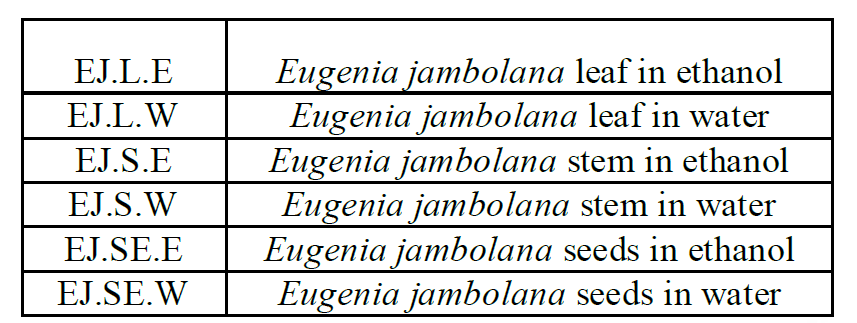
Table 1: Six collected crude extracts.

Table 2: Ethanolic Fractions extracts.
Qualitative phytochemical analysis
Qualitative phytochemical analysis was investigated by biochemical testing with the extracts of leaf, stem and seeds of Eugenia jambolana to detect the presence or absence of numerous primary and secondary metabolites with the help of standard protocols [8-11].
Quantitative Phytochemical Analysis
Quantitative phytochemical screening done by spectrophotometer method of ethanolic and aqueous extracts of E. jambolana to measure the total flavonoids, total alkaloids, total carbohydrate, total steroid, total phenol, total tannins and total carotenoids with the help of standard protocols [9].
DPPH scavenging antioxidant assay
1ml of ethanolic and water extract of each sample was taken and 1ml of DPPH was pipetted in all the samples very carefully. The reaction mixture was kept in dark for 24h. After incubation period, absorbance was measured at 517nm. Standard curve was drawn by taking ascorbic acid as standard.
Result
Qualitative phytochemical analysis
To check the qualitative phytochemical analysis of E. jambolana leaves, stem and seeds having the solvent water and ethanol. Current study showed the presence of primary and secondary phytoconstituents in ethanol and water extracts of E. jambolana. Some of the active ingredients present in each plant part under different extraction method were carbohydrate, saponins (Table 3).
Quantitative phytochemical analysis
Current study exposed that ethanolic leave and seed extracts contain highest quantity of bioactive compounds as compared to water solvent system as shown in Table 4. These bioactive compounds have great medicinal importance as it attributed high anti-diabetic, anti-oxidant, anti-inflammatory, anti-microbial, anti-bacterial, anti-HIV, and anti-fungal (Table 4) (Figures 1-6).
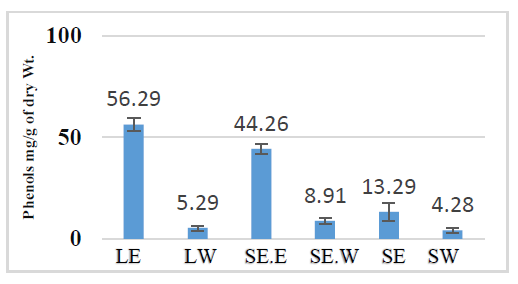
Figure 1: Quantification of Phenol.
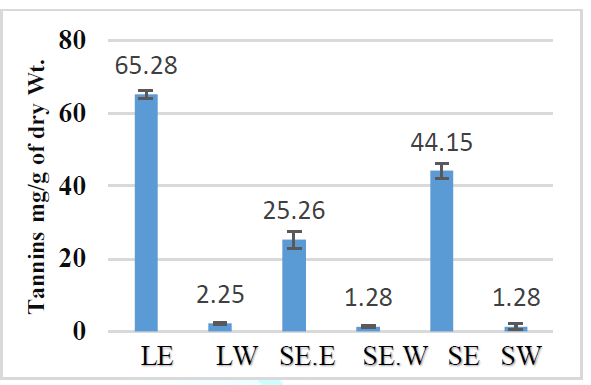
Figure 2: Quantification of Tannins.

Figure 3: Quantification of Alkaloids.
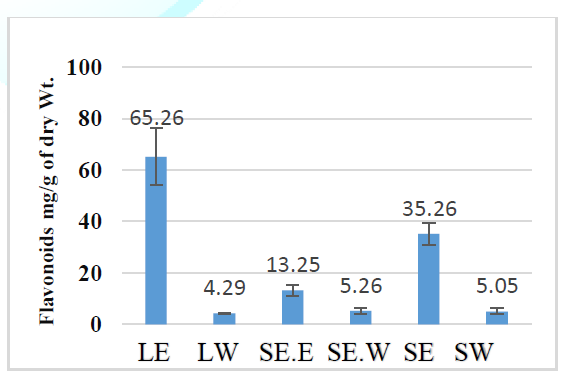
Figure 4: Quantification of Flavonoids.
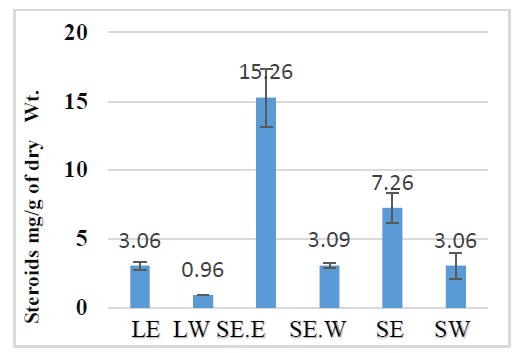
Figure 5: Quantification of Steroids.
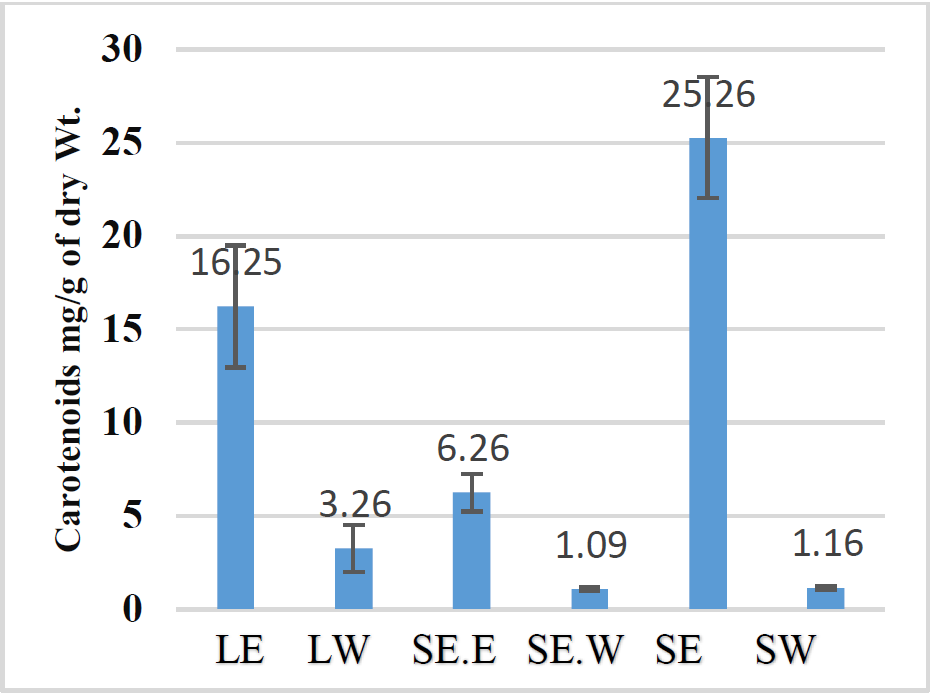
Figure 6: Quantification of Carotenoids.
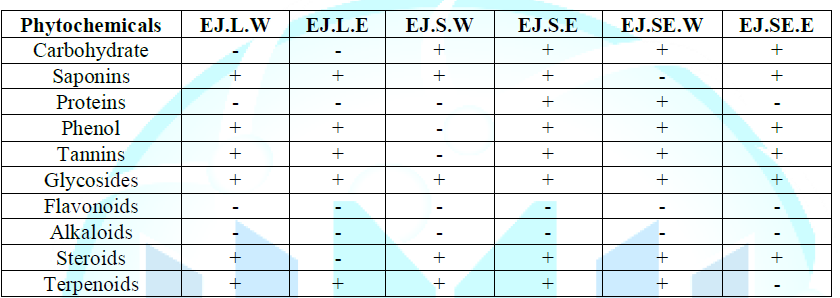

Table 4: Phytochemical characterization of Eugenia jambolana.
Result of Antioxidant activity
DPPH radical scavenging activity assay make known the significant antioxidant activity of Eugenia jambolana ethanolic seed and leaves extract than other extracts as shown in Table 5 and Figure 7.
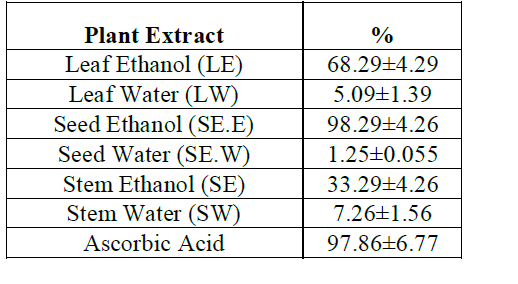
Table 5: DPPH free radical scavenging activity of Eugenia jambolana (%).
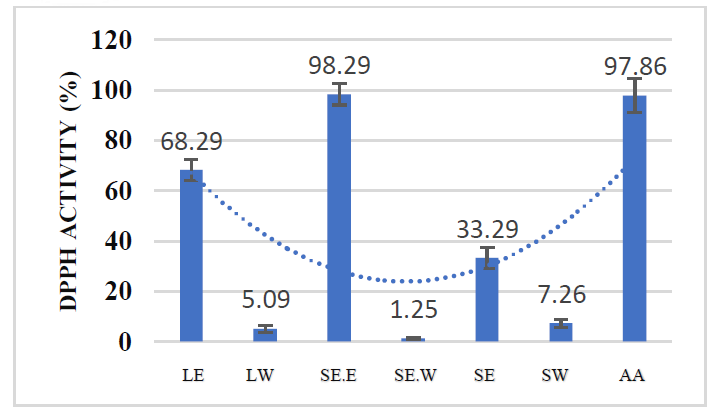
Figure 7: DPPH scavenging activity of Eugenia jambolana in ethanol and water solvent.
Discussion
Qualitative analysis of phytochemical compounds of Eugenia jambolana in methanolic extract and reveals the presence of amino acid, flavonoids, alkaloids, glycosides, saponins, tannins, steroids and triterpenoids. Recent results indicates that some phytochemicals components are present in both solvents, some presents only in ethanolic solvent and others are present in water solvent system [11]. A higher content of both total phenolics and flavonoids were found in the methanolic extract compared with other extracts [9]. Our current study of spectrophotometric analysis to quantified phytochemicals revealed that phenols, tannins, alkaloids, flavonoids, carotenoids and steroids present in high amount in ethanol extracts as comparison with water extracts.
Antioxidant activity of all extracts of Eugenia jambolana were examined by using two methods, namely DPPH and FRAP. In both methods, the methanol extract exhibited a higher antioxidant activity than methylene chloride and essential oil extracts [9]. Our present results demonstrate that ethanolic extracts contained maximum antioxidant activity than water extracts. The series of distribution of antioxidant activity was ethanolic seed extract>ethanolic leave extract>ethanolic stem extract>water stem extract>water leave extract>water seed extract.
Conclusion
The purpose of present research
work was to determine the phyto-constituents present in different parts of Eugenia jambolana qualitatively and quantitatively phytochemical
screening, and to investigate the antioxidant activity E. jambolana leaves, seeds and stem in ethanolic extracts exhibits
great amount of primary and secondary metabolites than the extracts of water solvent
system. Quantification results of
ethanolic and water extracts presented that it contains secondary metabolites while
ethanolic leaves and seed contains maximum secondary phyto-constituents.
Quantified result moreover demonstrated that some bioactive components are also
extant in extracts of Eugenia jambolana
in average amount but they were not identified by qualitative phytochemical screening.
Eugenia jambolana shows noticeable
antioxidant activity in ethanolic solvent system as compared to water solvent
system while ethanolic seeds and leaves keeps high antioxidant activity because
it contains rich amount of phytochemicals.
References
1. Ayyanar M, Subash-Babu P, Ignacimuthu S. Syzygium cumini (L.) Skeels: A novel therapeutic agent for diabetes: folk medicinal and pharmacological evidences (2013) Complementary Therapies in Medicine 21:232-243.
2. Hopley D, Smithers SG and Parnell K. The geomorphology of the Great Barrier Reef: development, diversity and change (2007) Cambridge University Press.
3. Mudiana D. Syzygium diversity in Gunung Baung, East Java, Indonesia (2016) Biodiversitas J Biolo Div 17.
4. Laouini SE, Segni L, Gherraf N, Ouahrani M R and Mokni, S. Scavenging activity, anti-inflammatory and diabetes related enzyme inhibition properties of ethanol leaves extract of Phoenyx dactylifera (2013) J Fundam Appl Sci 5:171-182. http://dx.doi.org/10.4314/jfas.v5i2.5
5. Nelvana R, Mahomoodally MF. Therapeutic potential of medicinal foods (2014) Adv Pharmacological Sci 18:354264. http://dx.doi.org/10.1155/2014/354264
6. Benherlal PS, Arumughan C. Chemical composition and in vitro antioxidant studies on Syzygium cumini fruit (2007) J Sci Food Agric 87: 2560-2569. https://doi.org/10.1002/jsfa.2957
7. Agbor GA, Moumbegna P, Oluwasola EO, Nwosu LU, Njoku, RC, et al. Antioxidant capacity of some plants foods and beverages consumed in the eastern region of Nigeria (2011) Afr J Tradit Complement Altern Med 8.
8. Thite SV, Chavan YR, Aparadh VT and Kore BA. Preliminary phytochemical screening of some medicinal plants (2013) Int J Pharm Chem Biol Sci 3:87-90.
9. Daniel NA, Ahmad FB, Assim Z and Pin CH. Phytochemical, cytotoxicity and antioxidant studies on the stem bark of Piper arborescence (2017) Malay J Fundam Appl Sci 13.
10. Shahnawaz M, Sheikh SA, Bhangar MI and Ahmed E. Total phenolic compounds and antioxidant activity of jamun fruit (Eugenia jambolana) products (2010) Pak J Food Sci 20:31-41.
11. Arun kumar S, Muthu Selvam M. Analysis of phytochemical constituents and antimicrobial activities of Aloe vera L. against clinical pathogens (2009) World J Agri Sci 5: 572-576.
Corresponding author:
Nureen Zahra, Institute of Molecular Biology and Biotechnology, University of Lahore, Pakistan, Tel: +92 (0)42 111-865-865, E-mail: nureenzahra@ymail.com
Citation:
Zahra N, Nadir M, Malik A, Shaukat A, Parveen A, et al. In Vitro phytochemical screening and antioxidant activity of jamun (Eugenia jambolana Linn) plants parts collected from Lahore, Pakistan (2019) Biochem Modern Appli 2: 20-23
Received: Oct 10, 2018


 PDF
PDF